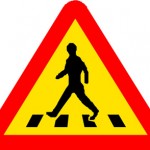These days when Jack and I walk the woodsy streets of our neighborhood, many of the trees are marked with hieroglyphics in red paint. Not every tree. Just some, both mature ones and saplings. One tree might have a dot on it, the next a line. Several have X’s, and a few are double-X-ed. Hundreds of different trunks are marked.
Trying to figure it out was impossible, and the marks seemed random… until I got an email from our home association with the explanation. Apparently our trees are threatening the power lines strung among them, and the red marks constitute detailed instructions to tree trimmers. Arborists will take careful note of each symbol before revving up their chain saws, because without obeying the marks, trimming wouldn’t accomplish the goal of the electric company, which is to clear its lines.
Life is full of important symbols, many of which can be understood without language, just like the tree markings. Take road signs, for example. In foreign countries if we understand the universal traffic symbols, we can still read the signs without having to know the language.
But what about signs and symbols we can’t understand?
Scripture is full of them, each one important. Jesus regularly spoke to his listeners through stories in which he wanted his facts to represent something else, demonstrating through symbolism how we should live. Once in a while he’d offer a direct explanation, but mostly he wouldn’t. So as we read Scripture today, what should we do if we can’t understand? What do we do with our resulting confusion?
There are two types of confusion referenced in the Bible: (1) the kind God superimposed on his enemies as a weapon, and (2) the innocent kind we might feel while trying to understand his Word. Although throwing his enemies into confusion was a tactical measure he often used, he has a different approach toward those who love him (like us) who become easily confused. In those cases, he wants to dispel confusion and increase our understanding.
God frequently reminds us that those who earnestly desire to comprehend the great truths of Scripture will be satisfied, though that doesn’t mean we’ll get answers to all our questions when we want them. What it does mean is that we’ll steadily increase in our understanding of him, which then will deeply satisfy us as we wait for explanations of what puzzles us spiritually. He wants us to know that the answers to all our problems are personified in him.
Getting closer in a relationship to Christ is the only sure route, then, to dispelling confusion over the perplexing symbolism of the Bible. Full understanding will only come when we meet him in eternal life.
And getting back to those marked trees in our forests, God didn’t need to read painted symbols to let him know which trees needed trimming. He knew all about it before the spray-painting arborists ever arrived.
“To the person who pleases him, God gives wisdom, knowledge and happiness.” (Ecclesiastes 2:26a)




